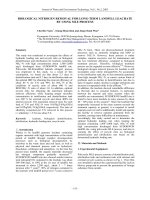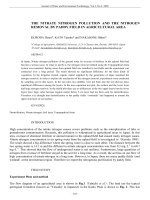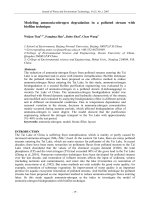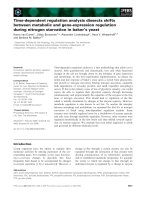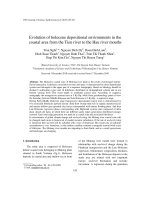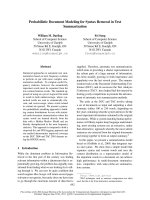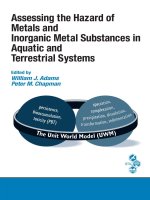Inorganic nitrogen removal in tropically coastal aquaculture ponds using integrated bioremediation
Bạn đang xem bản rút gọn của tài liệu. Xem và tải ngay bản đầy đủ của tài liệu tại đây (648.64 KB, 11 trang )
Journal of Marine Science and Technology; Vol. 17, No. 3; 2017: 320-330
DOI: 10.15625/1859-3097/17/3/9707
/>
INORGANIC NITROGEN REMOVAL IN TROPICALLY COASTAL
AQUACULTURE PONDS USING INTEGRATED BIOREMEDIATION
Do Manh Hao*, Dao Thi Anh Tuyet, Hoang Thi Thanh Nga,
Nguyen Tien Dat, Le Xuan Sinh, Tran Dinh Lan
Institute of Marine Environment and Resources, VAST
*
E-mail:
Received: 20-4-2017
ABSTRACT: Bioremediation technology has been emergently considered as an economic and
environmental-friendly manner to treat inorganic nitrogen in tropically coastal aquaculture ponds.
Two laboratory scale experiments were conducted to examine efficacy of nitrogen removal of some
bioremediators. The results indicated that total ammonia nitrogen (TAN) and nitrite concentrations
of treatments with inoculation of the nitrifying bacterial cultures were significantly lower than those
of the treatments without inoculation just after three days and one day of experiment, respectively.
TAN in treatments with inoculation was removed at 76.0% while that without inoculation was just
removed at 53.7%. Nitrite in treatments without inoculation increased duration of first 20
experiment days while nitrite in treatments with inoculation decreased to 50% just after one day. For
treatments with inoculation of denitrifying bacterial cultures, effect of nitrate removal was clear
within one day after beginning of the experiment. The present of macroalgae Gracilaria sp.
promoted TAN and nitrite removal after two to three days of the experiment. Moreover, the addition
of CaCO3 could enhance TAN and nitrite removal in comparison to the control treatments.
Keywords: Coastal aquaculture, inorganic nitrogen, bioremediation, nitrifying bacteria,
denitrifying bacteria.
INTRODUCTION
Reduced fishery harvests and increased
consumer demand for seafood have precipitated
an increase in intensive aquacultural farming,
particularly in coastal shrimp culture. However,
the rapid development of coastal aquaculture
has led to adverse environmental impacts.
Metabolic waste of culture organisms and
decomposition of uneaten feed, particularly
inorganic
nitrogen
compounds
usually
accumulate at concentrations much higher than
environmental carrying capacity. The excess
inorganic nitrogen became toxicity and reduced
shrimp growth rate and suppressed immune
competence [1-4]. One of the major
environmental concerns in aquatic animal
320
cultivation is the discharge of wastewaters
directly into coastal waters. Wastewater
pollutants promote organic enrichment,
sedimentation and toxicity. This set of factors
results in the deterioration of coastal
ecosystems and consequent loss of biodiversity
and primary productivity [5-10].
In order to solve the pollutant issues in
coastal
intensive
aquaculture,
several
approaches have been developed in recent
years for control of nitrogen compounds.
Bioaugmentation well-known as the seeding of
enriched nitrifying and denitrifying cultures
into intensive aquaculture has been studied.
Application of nitrifiers into shrimp ponds can
lead to decrease in ammonia and nitrate
Inorganic nitrogen removal in tropically coastal…
nitrogen in shrimp ponds [11-16]. In contrast,
other studies have indicated that effect of the
probiotics containing non-indigenous nitrifying
cultures is not stable as they will be edged out
by the competing native microorganisms,
besides facing growth inhibition and prolonged
acclimation period [17, 18].
Biostimulation
known
as
nutrient
supplementation, oxygen aeration, surface
substrata and so on is still limited but the
primary results showed the prospects. Diab and
Shilo [19] reported that Nitrosomonas sp. and
Nitrobacter sp. attached to the particles of
bentonite, CaCO3, amberlite had activity much
stronger than free-living strains; the attached
bacteria survived in anaerobic conditions for
several weeks while free-living bacteria only
survived for few days. Preceding studies also
showed that activities of nitrifying bacteria
improved significantly if attached to other
substrata such as zeolite, good particle [20, 21].
In addition, Barik et al., [16] indicated that the
application of enriched nitrifying bacteria
together with oxygen aeration improved
ammonia removal. Alkalinity in the form of
carbonate and bicarbonate has been used as a
nutrient element for nitrifying bacteria and
additive for maintenance of pH buffering
capacity in the nitrification in recirculating
aquaculture systems. Chen et al., [22]
recommended that a higher alkalinity
concentration of 200 mg.L−1 was needed to
maintain maximum nitrification rate in
recirculating aquaculture systems.
The use of macro-algae as nutrient
absorbers has proven to be a valid alternative
for nutrient bioremediation. The most
frequently tested organisms were Gracilaria sp.
which absorbs dissolved inorganic nutrients [5,
23-25]. The present study examined in
laboratory-scale the in-situ bioremediation
potential of indigenous nitrifier and denitrifier
cultures, substrata, macroalgae Gracilaria sp.
and alkalinity on inorganic nitrogen removal in
coastal intensive aquaculture ponds.
MATERIAL AND METHODS
Enrichment of nitrifying bacterial cultures
The nitrifying bacterial strains isolated
from shrimp pond sediments along coastal zone
of Hai Phong city, in the northeast of Vietnam,
were enriched primarily in sterilized 250 mL
conical flasks containing a working volume of
100 mL of mineral culture media (according to
Watson et al., [26]) at 28°C on a rotary shaker,
and substrate concentrations were 20 mg.L−1 for
Nitrosomonas sp. and 10 mg.L−1 for
Nitrobacter sp. All of the flasks were
monitored daily for substrate concentrations
and pH adjustment. Sub-culture into secondary
media at a 1:9 ratio (v/v) was carried out when
the growth of cultures entered near stationary
phase, marked with the cessation of substrate
consumption. Sub-culturing is terminated when
time for substrate removal was considerably
shortened down to 30 - 40 h.
To prepare immobilized nitrifying bacterial
cultures (INBC), the inoculums of secondary
enriched nitrifying bacterial culture (NBC)
were incubated into 500 mL conical flasks with
an initial TAN and nitrite concentration of
20 mg.L−1 and 10 mg.L−1, respectively. The
flasks were kept in darkness and continuously
aerated; pH was maintained between 7.5 and
8.0. When the log phase of TAN and nitrite
removal was detected, sterile zeolite particles
(autoclaved at 121°C, 15 min) were added into
cultures. Culture immobilization onto zeolite
particles was then undertaken at 10 h, 30 h and
60 h to determine the optimal immobilization
period [20].
Enrichment of
cultures (DBC)
denitrifying
bacterial
The isolated denitrifying bacterial strains
were enriched primarily in 100 mL sterile
conical flasks containing a working volume of
50 mL glucose-yeast extract media with NNO3− 0.1 g.L−1 at 28°C without shaking. All
flasks were monitored every 10 hours for
substrate concentrations. Sub-culture into
secondary media at a 1:9 ratio (v/v) was carried
out when the growth of cultures entered near
stationary phase, marked with the cessation of
substrate consumption. Sub-culturing was
terminated when time for substrate removal
was considerably shortened down to 8 - 12 h.
321
Do Manh Hao, Dao Thi Anh Tuyet,…
Acclimatization of macroalgae Gracilaria sp.
Specimens of Gracilaria sp. were collected
at
Lach
Tray
estuary
(20°45’27”N;
106°46’32”E) located in the northeast of
Vietnam. After collection, the specimens were
taken to the laboratory where they were washed
with seawater to remove sediment. Then the
macroalgae were kept in an aquarium
containing 50 L of seawater that was collected
from aquaculture canal of Lach Tray estuary,
under constant aeration and photoperiod of
12:12 h light:dark cycle. The conditions were
maintained for 10 days of pre-acclimatization
until starting of the experiment.
Experimental design
Experimental design 1
The experiment was set up to focus on
effect evaluation of the additive of enriched
nitrifying bacterial cultures and different
substrata on the removal of TAN and nitrite.
The experiment was designed into ten
treatments in duplicates as follows:
I1S: with inoculum of NBC at 100 L.L−1,
without substratum;
I2S: without inoculum of NBC, without
substratum;
−1
I1ZB: with inoculum of NBC at 100 L.L ,
with zeolite substratum;
I2ZB: without inoculum of NBC, with
zeolite substratum;
−1
I1SB: with inoculum of NBC at 100 L.L ,
with sand substratum;
I2SB: without inoculum of NBC, with
sand substratum;
I1GB: with inoculum of NBC
100 L.L−1, with gravel substratum;
at
I2GB: without inoculum of NBC, with
gravel substratum;
I1CB: with inoculum of NBC at
100 L.L−1, with coral fragment substratum;
I2CB: without inoculum of NBC, with
coral fragment substratum.
322
Experiment was carried out in twenty
aquaria (25 × 25 × 30 cm) that were stocked
with four of Asian tiger shrimp (Penaeus
monodon), post 15. Because the seawater in
aquaculture canal was received directly from
the discharge of many aquaculture ponds, we
chose the water sources to carry out
experiment. Each aquarium was filled up to
15 L with the seawater collected from
aquaculture canal in Lach Tray estuary. Twenty
aerators were used in aquaria for aeration.
Aeration in aquaria tanks was achieved by
passing of the air from air pump through a
submerged block of porous material called air
stone along with regulators. Shrimp was fed 5
times a day for 37 days, 24 mg food per each
time for each aquarium. Temperature, pH, DO
and dissolved nutrients (TAN, nitrite and
nitrate) were monitored daily.
Experiment design 2
The experiment was set up to clarify further
the effect of individual bioremediators as well
as the comprehensive effect of those
bioremediators on inorganic nitrogen removal.
The experiment was designed into six
treatments in triplicate as follows:
Control: without any additives.
INBC-DBC: with inoculums of INBC and
DBC at 100 L.L−1.
Zeolite: with TAN saturated zeolite.
Gracilaria: with Gracilaria sp.
CaCO3: with CaCO3.
INBC-DBC-Zeolite-CaCO3: with inoculums of INBC and DBC, and addition of zeolite
and CaCO3.
Experiment was carried out in eighteen
aquaria (45×45×40 cm) that were stocked with
twelve of Asian tiger shrimp (Penaeus
monodon), post 15 each aquarium. The
aquarium was added a layer of 5 cm of sand
bed and filled with seawater up to 50 L. The
sand and seawater were collected from
aquaculture canal in Lach Tray estuary. Twelve
aerators were used in aquaria for aeration.
Aeration in aquaria tanks was achieved by
passing of the air from air pump through a
Inorganic nitrogen removal in tropically coastal…
submerged block of porous material called air
stone along with regulators. Shrimp were fed 4
times a day for 11 days, 0.4 g food per each
time. Temperature, pH, DO and dissolved
nutrients (TAN, nitrite and nitrate) were
monitored daily.
Analytical procedures
Dissolved oxygen, water temperature and
salinity were measured by using YSI model 57
dissolved oxygen meter (YSI Incorporated,
Ohio, USA) and Atago refractometer (Atago
Co., LTD, Tokyo, Japan), respectively. pH was
measured with the help of a pH meter (704,
Metrohm, Germany). TAN was analyzed by
phenate method described by Solórzano [27].
Nitrite-nitrogen (N-NO2−) was measured by
diazotization method described by Strickland
and Parson [28]. Nitrate nitrogen (N-NO3−) was
firstly reduced into NO2− by cadmium column,
and then formed nitrite measured by
diazotization method [28].
NBC decreased 76.0% while those without
inoculation just decreased 53.7% in comparison
with the first experiment day. After five days of
the experiment, TAN concentration of the
treatments with inoculum was about 0.016
mg.L−1 TAN removal at 99.4% while TAN
concentration of the treatments without
inoculum was about 0.835 mg.L−1 TAN
removal at 67.8%.
Statistical analysis
Significant differences of variables (TAN,
N-NO2−, N-NO3−) between treatments with
inoculation of NBC and treatments without
inoculation of NBC in the first experiment were
analyzed by t-Test. Those of the variables
among six treatments in second experiment
were analyzed by simple analysis of variance
(ANOVA). The statistical analysis was
performed using Excel package 2010
(Microsoft).
RESULTS AND DISCUSSION
Effect of enriched nitrifying
cultures on TAN removal
bacteria
In the first experiment, TAN concentration
of all treatments tended to decrease during
experimental time course. TAN concentration
of the treatments with inoculation of nitrifying
bacteria cultures (NBC) was lower than that of
the treatments without inoculation of NBC. Just
after three days of the experiment, average
TAN concentration of the treatments with
inoculation of NBC was significantly lower
than that of the treatments without inoculation
of NBC (p < 0.005) (fig. 1a). TAN
concentrations in treatments with inoculation of
Fig. 1. Temporal variation of TAN
concentration of different treatments,
(a): Treatments with inoculation and without
inoculation in the first experiment,
(b): Treatments with inoculation of INBC-DBC
and treatments with the addition of different
bioremediators in the second experiment
In
the
second
experiment,
TAN
concentration of the treatments with inoculation
of INBC-DBC, zeolite particles, and INBCDBC-Zeolite-CaCO3 all tended to be higher
than that of the control treatment during first
four days of the experiment. Then, TAN
concentration of the treatment with inoculation
of INBC-DBC and INBC-DBC-Zeolite-CaCO3
tended to be lower than that of the control
treatment while TAN concentration in
treatment with zeolite particles was higher than
TAN concentration in control treatment
(fig. 1b). The result showed that in the first four
days of the experiment, TAN of the treatments
with inoculation of INBC-DBC, zeolite particle
and INBC-DBC-Zeolite-CaCO3 were produced
by ammonification of DBC and TAN release of
323
Do Manh Hao, Dao Thi Anh Tuyet,…
ammonium-saturated zeolite particles. TAN of
the treatment with INBC-DBC lower than TAN
of the control treatment from 5th - 9th day
proved that the inoculation of INBC distributed
the removal of TAN of the treatments with
INBC-DBC and INBC-DBC-Zeolite-CaCO3.
TAN of the treatment with INBC-DBC-ZeoliteCaCO3 much lower than TAN of the treatment
with INBC-DBC showed synergy effect of
immobilized nitrifying bacteria and addition of
CaCO3 in TAN removal.
The enriched inoculums of indigenous
nitrifying bacteria in both suspended and
attached states had significant effect on TAN
removal within five days of the experiment.
Study results of Grommen et al., [29] and Barik
et al., [16] had shown that ammonia nitrogen
concentration in treatments with Nitrosomonas
and Nitrobacter inoculums decreased from 10
mg L−1 to below the minimum limit
(0.3 mg.L−1) within 3-5 days after inoculation.
Effect of enriched nitrifying
cultures on nitrite removal
bacterial
Just after one day of the first experiment,
average NO2− concentration of the treatments
with inoculation of NBC was significantly
lower than that of the treatments without
inoculation of NBC (p < 0.001). Nitrite
concentration in treatments with inoculation
decreased 50% compared to that on the first
day while nitrite concentration in treatments
without inoculation increased twice. During
sixteen days of the experiment, NO2−
concentration of the treatments with inoculation
of NBC tended to decrease from 0.06 mg.L−1
on the first day to 0.03 mg.L−1 on the sixteenth
day while NO2− concentration of the treatments
without of NBC tended to increase from 0.06
mg.L−1 on the initial day to 0.13 mg.L−1 on the
sixteenth experimental day. Since twenty days
of the experiment, there were significant
differences (p < 0.05) in NO2− concentrations
between treatments with and without
inoculation of NBC at the same time (fig. 2a).
The result showed that NBC could improve
considerably nitrite removal only after one day
and the effect of nitrite removal could last for
sixteen days.
324
Fig. 2. Temporal variation of nitrite
concentration of different treatments,
(a): Treatments with inoculation and without
inoculation in the first experiment,
(b): Treatments with inoculation of INBC-DBC
and treatments with the addition of different
bioremediators in the second experiment
Just after one day of the second experiment,
NO2− concentration of the treatments with
inoculation of INBC-DBC and INBC-DBCZeolite-CaCO3 was significantly higher than
that of the control treatment (p < 0.05). After
two days of the experiment, NO2−
concentration of the treatment with supplement
of zeolite was significantly higher than that of
the control treatment (p < 0.05) (fig. 2b). Being
similar to the dynamic trend of TAN
concentration, NO2− concentration of the
treatments with inoculation of INBC-DBC and
INBC-DBC-Zeolite-CaCO3 was higher than
that of the control treatment during first five
days of the experiment and then that of the
treatments was much lower than that of the
control
treatment.
Meanwhile
NO2−
concentration of the treatment with supplement
of zeolite was not significantly lower than that
of the control treatment since next days of the
experiment. The result showed that INBC
distributed considerably the removal of NO2− of
the treatment with inoculation of INBC.
However, during the first day of the
experiment, high NO2− concentration of the
Inorganic nitrogen removal in tropically coastal…
treatments was caused by ammonification of
DBC, TAN and NO2− release from zeolite
particles.
Effect of enriched denitrifying bacterial
cultures on nitrate removal
Effect of denitrifying bacterial cultures
(DBC) on nitrate removal was proven in the
second experiment, nitrate concentration of the
treatments with inoculation of DBC including
of INBC-DBC and INBC-DBC-Zeolite-CaCO3
decreased strongly from 1.10 mg.L−1 on initial
day to 0.06 mg.L−1 on first day of the
experiment. Then nitrate concentration of the
treatments was always maintained at low level
in comparison to the control treatment (fig. 3).
The vast majority of aquaculture ponds
accumulated nitrate but there were very few
studies interested in the nitrate removal in
coastal aquaculture. Recently, there were some
studies interested in development of
denitrification
reactors
integrated
into
recirculating aquaculture systems [30-32].
3.500
3.000
2.500
supplement of substrata tended to be lower than
TAN of the treatment without supplement of
substrata (fig. 4a). For the treatments without
inoculation
of
NBC,
average
TAN
concentrations between treatments with
supplement of substrata and without
supplement of substrata were not significantly
different on the first day of experiment. From
the third day of the experiment, average TAN
concentrations of the treatments with
supplement of substrata tended to be lower than
those of the treatments without supplement of
substrata (fig. 4b). The result showed that
presence of substrata in environment could
contribute to improving TAN removal in both
conditions with and without inoculation of
NBC.
Control
INBC-DBC
Zeolite
Gracilaria
N-NO3 - (mg.L-1 )
CaCO3
2.000
INBC-DBC-Gracilaria-CaCO3
1.500
1.000
0.500
0.000
Initial
1
2
3
4
5
7
9
Experiment time (day)
Fig. 3. Temporal variation of nitrate
concentration in treatments with different
bioremediators in second experiment
Effect of substrata on TAN removal
In the first experiment, we used four
different substrata to assess their effect on
removal of TAN and nitrite. For the treatments
with inoculation of NBC, there were no
significant differences in TAN concentration
among those treatments on first day of the
experiment. Except the treatment with
substratum of sand, TAN of the treatment was
maintained at concentration significantly lower
than that of the other treatments. From the third
day of the experiment, average TAN
concentration of the treatments with
Fig. 4. Temporal variation of TAN in
treatments with different substrata,
(a): With inoculation of NBC, (b): Without
inoculation of NBC
For the treatments with inoculation of
NBC, TAN concentration of the treatment
supplied with substratum of sand was much
lower than that of the other treatments on the
first and third days of the experiment. From the
fifth day of the experiment, because TAN in all
treatments at different times was maintained at
low concentration, less than 0.163 mg.L−1, we
could not find considerable difference in TAN
concentrations among treatments with different
325
Do Manh Hao, Dao Thi Anh Tuyet,…
substrata. For the treatments without
inoculation of NBC, on the first day of the
experiment, TAN concentration of the
treatment with supplement of sand substratum
was lower than that of the other treatments. But
on the third day of the experiment, TAN
concentration of the treatment was higher than
that of the other treatments. On the fifth day of
the experiment, TAN concentration in the
treatment with supplement of coral was lowest,
followed by that with supplement of gravel,
zeolite and sand (fig. 4a, 4b). From the eighth
day of experiment, we could not find a clear
trend in TAN removal of the treatments with
different substrata. The results showed that
although different substrata had TAN removal
effect at different levels, we could not find out
considerable difference in TAN removal among
those treatments with supplement of the four
different substrata.
Effect of substrata on nitrite removal
Fig. 5. Temporal variation of nitrite in
treatments with different substrata,
(a): With inoculation of NBC; (b): Without
inoculation of NBC
For the treatments with inoculation of
NBC, average nitrite concentration in the
treatments with supplement of substrata was
lower than that in the treatments without
supplement of substrata during time course of
the experiment. However, for the treatments
326
with inoculation of NBC, average nitrite
concentrations in the treatments with
supplement of substratum were lower than
those in the treatments without substratum on
the first and third days of the experiment. From
the eighth to twenty fifth days of the
experiment, average nitrite concentration of the
treatments with substrata was much higher than
nitrite in the treatments without substratum.
From thirty seventh to forty fourth days,
average nitrite concentration in the treatments
with substrata was much lower than nitrite
concentration in the treatments without
substratum (fig. 5a). The result showed that
effect of the application of substrata on nitrite
removal was enhanced in synergy with
inoculation of NBC.
Effect of nitrite removal of different
substrata in treatments with inoculation of NBC
is showed in fig. 5a. Although nitrite
concentrations in treatments with different
substrata were not similar at given time, we
could not find a clear trend of distinction in
nitrite concentration throughout time course of
experiment. Except treatment with supplement
of coral substratum, nitrite concentration in the
treatment was lower than that in other
treatments, particularly at the last time of the
experiment. In treatments without inoculation
of NBC, effect of nitrite removal of different
substrata is showed in fig. 5b. Similar to
treatments with supplement of substrata, there
was not a general trend of distinction in nitrite
concentration throughout time course of the
experiment. However, nitrite concentration in
the treatment with supplement of coral
substratum was lower than that in the other
treatments, particularly at the last time of the
experiment.
TAN and nitrite in the treatments with
supplement of substrata were maintained at
concentrations lower significantly than those in
the treatments without supplement of substrata.
The trend was clearer in the treatments with
inoculation of NBC. However, the study has
not revealed removal effect of the inorganic
nitrogen of four chosen different substrata.
Effect of Gracilaria sp. on inorganic nitrogen
removal
Inorganic nitrogen removal in tropically coastal…
Fig. 1b showed effect of Gracilaria sp. on
TAN removal in the second experiment. TAN
concentration of the treatment with application
of the macroalgae Gracilaria was significantly
lower than that of the control treatment after
second day of the experiment (p < 0.05). Then
TAN concentrations in the treatment with
application of the macroalgae Gracilaria were
lower than those in the control treatment
throughout time course of the experiment.
Fig. 2b showed effect of Gracilaria sp. on
nitrite removal in the second experiment.
Nitrite concentration of the treatment with
application of Gracilaria sp. was significantly
lower than that of the control treatment after
three days of the experiment (p < 0.05). Then,
nitrite concentrations in the treatment with
application of the macroalgae Gracilaria were
much lower than those in the control treatment
throughout time course of the experiment
(p < 0.001).
Fig. 3 showed effect of Gracilaria sp. on
nitrate removal in the second experiment.
Nitrate concentrations in treatment with
application of macro-algae Gracilaria tended to
be higher than those in control treatment
throughout time course of experiment. Just
after one day of the experiment, nitrate
concentration of the treatment with application
of the macroalgae Gracilaria was significantly
higher than nitrate of the control treatment
(p < 0.05).
The present study showed that Gracilaria
sp. could be used as a bioremediator in the
treatment of TAN and nitrite in coastal
aquaculture. According to study results of
Marinho-Soriano et al. [24], macro-algae
Gracilaria caudata performed well in
absorbing nitrogen forms. According to
McGowan [33], Ando et al. [34], sediment
characteristics decided nitrification rate of
indigenous bacteria, sand sediment with
seagrass Zostera marina was demonstrated to
effectively remove ammonia compared with the
sediment without the seagrass.
Effect of alkalinity on inorganic nitrogen
removal
Effect of alkalinity on TAN removal in the
second experiment is showed in fig. 1b. TAN
concentration of the treatment with application
of CaCO3 was significantly lower than TAN
concentration of the control treatment
(p < 0.05). Then, nitrate concentrations of the
treatment with application of CaCO3 were
much lower than those in the control treatment
throughout experimental time.
Effect of alkalinity on nitrite removal in the
second experiment is showed in fig. 2b. Nitrite
concentration of the treatment with application
of CaCO3 was significantly lower than that of
the control treatment after three days of the experiment (p < 0.05). Then nitrite concentrations
in the treatment were much lower than those in
the control treatment (p < 0.001).
Effect of alkalinity on nitrate removal in the
second experiment is showed in fig. 3. Nitrate
concentration in treatment with application of
CaCO3 was lower significant than that in
control treatment (p < 0.05) after just one day
of experiment. Then nitrate concentrations of
the treatment with application of CaCO3 were
much higher than those in the control treatment
(p < 0.001).
According to Chen et al. [35], the rate of
nitrification would be reduced when alkalinity
was below 40 g.m−3. For the case of
nitrification, Gujer and Boller [36] reported that
alkalinity level of at least 75 mg.L−1 was
needed to maintain maximum nitrification rate
in nitrifying biofilters of municipal wastewater
treatment. In fact, alkalinity in the form of
carbonate and bicarbonate was a nutrient
element for nitrifying bacteria. In addition,
alkalinity provided the buffering capacity that
was necessary to prevent pH changes due to
acid production nitrification process [22].
CONCLUSIONS
The study demonstrated that the indigenous
nitrifying and denitrifying bacterial cultures,
the macro-algae Gracilaria sp. and CaCO3
were potential bioremediators in treatment of
TAN, nitrite and nitrate in tropically coastal
intensive aquaculture. These technologies were
feasible options in terms of economics and
environmental concerns. In this study, we also
demonstrated effect of substrata on TAN and
327
Do Manh Hao, Dao Thi Anh Tuyet,…
nitrite removal, TAN and nitrite in the
treatments with supplement of substrata were
maintained at concentrations lower than those
in the treatments without supplement of
substrata. The trend was clearer for the
treatments with inoculation of NBC.
Acknowledgments: The work was supported by
the research grant from National Foundation
for Science and Technology Development
(Project
code:
106-NN.05-2015.75),
VAST.DA47.DA.12/15-18
and
CCoreRENSEA (JSPS, FY2016-2018).
REFERENCES
1. Chin, T. S., and Chen, J. C., 1987. Acute
toxicity of ammonia to larvae of the tiger
prawn, Penaeus monodon. Aquaculture,
66(3-4), 247-253.
2. Muir, P. R., Sutton, D. C., and Owens, L.,
1991. Nitrate toxicity to Penaeus monodon
protozoea. Marine Biology, 108(1), 67-71.
3. Boyd, C. E., 1998. Water quality for pond
aquaculture.
Alabama
Agriculture
Experimental Station, Auburn University,
Alabama. 37 pp.
4. Gross, A., Abutbul, S., and Zilberg, D.,
2004. Acute and Chronic Effects of Nitrite
on white shrimp, Litopenaeus vannamei,
cultured in low‐salinity brackish water.
Journal of the World Aquaculture Society,
35(3), 315-321.
5. Chopin, T., Buschmann, A. H., Halling, C.,
Troell, M., Kautsky, N., Neori, A.,
Kraemer, G. P., Zertuche-González, J. A.,
Yarish, C., and Neefus, C., 2001.
Integrating
seaweeds
into
marine
aquaculture systems: a key toward
sustainability. Journal of Phycology, 37(6),
975-986.
6. Burford, M. A., Costanzo, S. D., Dennison,
W. C., Jackson, C. J., Jones, A. B.,
McKinnon, A. D., Preston, N. P., and Trott,
L. A., 2003. A synthesis of dominant
ecological processes in intensive shrimp
ponds and adjacent coastal environments in
NE Australia. Marine Pollution Bulletin,
46(11), 1456-1469.
7. Worm, B., Sandow, M., Oschlies, A., Lotze,
328
H. K., and Myers, R. A., 2005. Global
patterns of predator diversity in the open
oceans. Science, 309(5739), 1365-1369.
8. Anh, P. T., Kroeze, C., Bush, S. R., and
Mol, A. P., 2010. Water pollution by
intensive brackish shrimp farming in southeast Vietnam: Causes and options for
control. Agricultural Water Management,
97(6), 872-882.
9. Parker, A. E., Dugdale, R. C., and
Wilkerson, F. P., 2012. Elevated ammonium
concentrations from wastewater discharge
depress primary productivity in the
Sacramento river and the Northern San
Francisco estuary. Marine Pollution
Bulletin, 64(3), 574-586.
10. Isobe, K., and Ohte, N., 2014. Ecological
perspectives on microbes involved in Ncycling. Microbes and Environments, 29(1),
4-16.
11. Prabhu, N. M., Nazar, A. R., Rajagopal, S.,
and Khan, S. A., 1999. Use of probiotics in
water quality management during shrimp
culture. Journal of Aquaculture in the
Tropics, 14(3), 227-233.
12. Shariff, M., Yusoff, F. M., Devaraja, T. N.,
and Rao, P. S., 2001. The effectiveness of a
commercial microbial product in poorly
prepared tiger shrimp, Penaeus monodon
(Fabricius), ponds. Aquaculture Research,
32(3), 181-187.
13. Sambasivam, S., Chandran, R., and Khan,
S. A., 2003. Role of probiotics on the
environment of shrimp pond. Journal of
Environmental Biology, 24(1), 103-106.
14. Rombaut, G., Grommen, R., Zizhong, Q.,
Vanhoof, V., Suantika, G., Dhert, P.,
Sorgeloos, P., and Verstraete, W., 2003.
Improved performance of an intensive
rotifer culture system by using a nitrifying
inoculum (ABIL). Aquaculture Research,
34(2), 165-174.
15. Janeo, R. L., Corre, V. L., and Sakata, T.,
2009. Water quality and phytoplankton
stability in response to application
frequency of bioaugmentation agent in
shrimp ponds. Aquacultural Engineering,
40(3), 120-125.
Inorganic nitrogen removal in tropically coastal…
16. Barik, P., Vardia, H. K., and Gupta, S. B.,
2011. Bioremediation of ammonia and
nitrite in polluted water. International
Journal of Fisheries and Aquaculture, 3(7),
136-142.
17. Stephenson, D., and Stephenson, T., 1992.
Bioaugmentation for enhancing biological
wastewater
treatment.
Biotechnology
Advances, 10(4), 549-559.
18. Gatesoupe, F. J., 1999. The use of
probiotics in aquaculture. Aquaculture,
180(1), 147-165.
19. Diab, S., and Shilo, M., 1988. Effect of
adhesion to particles on the survival and
activity of Nitrosomonas sp. and
Nitrobacter sp. Archives of Microbiology,
150(4), 387-393.
20. Shan, H., and Obbard, J., 2001. Ammonia
removal from prawn aquaculture water
using immobilized nitrifying bacteria.
Applied Microbiology and Biotechnology,
57(5), 791-798.
21. Manju, N. J., Deepesh, V., Achuthan, C.,
Rosamma, P., and Singh, I. B., 2009.
Immobilization of nitrifying bacterial
consortia
on
wood
particles
for
bioaugmenting nitrification in shrimp
culture systems. Aquaculture, 294(1), 6575.
22. Chen, S., Ling, J., and Blancheton, J. P.,
2006. Nitrification kinetics of biofilm as
affected by water quality factors.
Aquacultural Engineering, 34(3), 179-197.
23. Neori, A., Chopin, T., Troell, M.,
Buschmann, A. H., Kraemer, G. P., Halling,
C., Shpigel, M., and Yarish, C., 2004.
Integrated aquaculture: rationale, evolution
and state of the art emphasizing seaweed
biofiltration in modern mariculture.
Aquaculture, 231(1), 361-391.
24. Marinho-Soriano, E., Azevedo, C. A. A.,
Trigueiro, T. G., Pereira, D. C., Carneiro,
M. A. A., and Camara, M. R., 2011.
Bioremediation of aquaculture wastewater
using
macroalgae
and
Artemia.
International
biodeterioration
and
Biodegradation, 65(1), 253-257.
25. Raja, S., Dinesh, K. P. B., Kesavan, K.,
Kodungallur, T., and Thrissur, K., 2014.
Bioremediation by using of microbes and
algae with special reference to coastline
environment. Int. J. Biosci. Nanosci, 1(6),
130-140.
26. Watson, S. W., Bock, E., Harms, H., Koops,
H., and Hooper, A. B., 1989. Nitrifying
bacteria, in Bergey's Manual of Systematic
Bacteriology (eds Stanley, J. T., Bryant, M.
P., Pfennig, N., and Holt, J. G.), Williams &
Wilkins, Baltimore, pp. 1808-1834.
27. Solorzano, L., 1969. Determination of
ammonia in natural waters by the
phenolhypochlorite method. This research
was fully supported by US Atomic Energy
Commission Contract No. ATS (11‐1) GEN
10, PA 20. Limnology and oceanography,
14(5), 799-801.
28. Strickland, J. D., and Parsons, T. R., 1972.
A practical handbook of seawater analysis.
Fisheries Research Board of Canada,
Ottawa.
29. Grommen, R., Van Hauteghem, I., Van
Wambeke, M., and Verstraete, W., 2002. An
improved nitrifying enrichment to remove
ammonium and nitrite from freshwater
aquaria systems. Aquaculture, 211(1),
115-124.
30. Van Rijn, J., Tal, Y., and Schreier, H. J.,
2006. Denitrification in recirculating
systems:
theory
and
applications.
Aquacultural Engineering, 34(3), 364-376.
31. Tal, Y., Schreier, H. J., Sowers, K. R.,
Stubblefield, J. D., Place, A. R., and Zohar,
Y., 2009. Environmentally sustainable landbased marine aquaculture. Aquaculture,
286(1), 28-35.
32. Müller-Belecke, A., Zienert, S., Thürmer,
C., Kaufhold, S., and Spranger, U., 2013.
The
“self
cleaning
inherent
gas
denitrification-reactor”
for
nitrate
elimination in RAS for pike perch (Sander
lucioperca)
production.
Aquacultural
Engineering, 57, 18-23.
33. McGowan, C. J., 2007. Nitrification
Potential and Nitrate Reduction to
Ammonium in a Nitrogen-Polluted Estuary
329
Do Manh Hao, Dao Thi Anh Tuyet,…
Doctoral dissertation, Brown University,
(date). 29 pp.
34. Ando, Y., Nakagawa, T., Takahashi, R.,
Yoshihara, K., and Tokuyama, T., 2009.
Seasonal changes in abundance of
ammonia-oxidizing archaea and ammoniaoxidizing bacteria and their nitrification in
sand of an eelgrass zone. Microbes and
Environments, 24(1), 21-27.
330
35. Chen, G. H., Ozaki, H., and Terashima, Y.,
1989. Modelling of the simultaneous
removal of organic substances and nitrogen
in a biofilm. Water Science and Technology,
21(8-9), 791-804.
36. Gujer, W., and Boller, M., 1986. Design of
a nitrifying tertiary trickling filter based on
theoretical concepts. Water Research,
20(11), 1353-1362.
